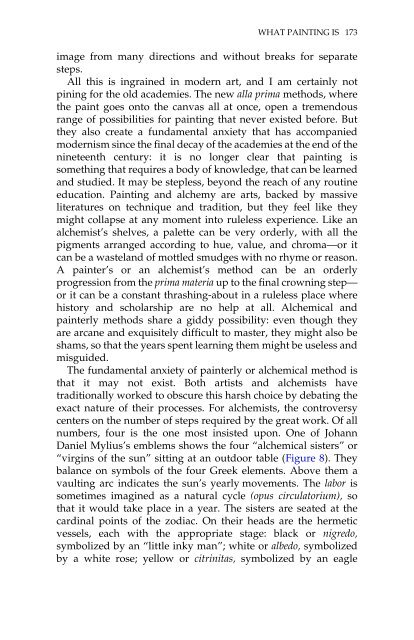What Painting Is: How to Think about Oil Painting ... - Victoria Vesna
What Painting Is: How to Think about Oil Painting ... - Victoria Vesna
What Painting Is: How to Think about Oil Painting ... - Victoria Vesna
You also want an ePaper? Increase the reach of your titles
YUMPU automatically turns print PDFs into web optimized ePapers that Google loves.
WHAT PAINTING IS 173<br />
image from many directions and without breaks for separate<br />
steps.<br />
All this is ingrained in modern art, and I am certainly not<br />
pining for the old academies. The new alla prima methods, where<br />
the paint goes on<strong>to</strong> the canvas all at once, open a tremendous<br />
range of possibilities for painting that never existed before. But<br />
they also create a fundamental anxiety that has accompanied<br />
modernism since the final decay of the academies at the end of the<br />
nineteenth century: it is no longer clear that painting is<br />
something that requires a body of knowledge, that can be learned<br />
and studied. It may be stepless, beyond the reach of any routine<br />
education. <strong>Painting</strong> and alchemy are arts, backed by massive<br />
literatures on technique and tradition, but they feel like they<br />
might collapse at any moment in<strong>to</strong> ruleless experience. Like an<br />
alchemist’s shelves, a palette can be very orderly, with all the<br />
pigments arranged according <strong>to</strong> hue, value, and chroma—or it<br />
can be a wasteland of mottled smudges with no rhyme or reason.<br />
A painter’s or an alchemist’s method can be an orderly<br />
progression from the prima materia up <strong>to</strong> the final crowning step—<br />
or it can be a constant thrashing-<strong>about</strong> in a ruleless place where<br />
his<strong>to</strong>ry and scholarship are no help at all. Alchemical and<br />
painterly methods share a giddy possibility: even though they<br />
are arcane and exquisitely difficult <strong>to</strong> master, they might also be<br />
shams, so that the years spent learning them might be useless and<br />
misguided.<br />
The fundamental anxiety of painterly or alchemical method is<br />
that it may not exist. Both artists and alchemists have<br />
traditionally worked <strong>to</strong> obscure this harsh choice by debating the<br />
exact nature of their processes. For alchemists, the controversy<br />
centers on the number of steps required by the great work. Of all<br />
numbers, four is the one most insisted upon. One of Johann<br />
Daniel Mylius’s emblems shows the four “alchemical sisters” or<br />
“virgins of the sun” sitting at an outdoor table (Figure 8). They<br />
balance on symbols of the four Greek elements. Above them a<br />
vaulting arc indicates the sun’s yearly movements. The labor is<br />
sometimes imagined as a natural cycle (opus circula<strong>to</strong>rium), so<br />
that it would take place in a year. The sisters are seated at the<br />
cardinal points of the zodiac. On their heads are the hermetic<br />
vessels, each with the appropriate stage: black or nigredo,<br />
symbolized by an “little inky man”; white or albedo, symbolized<br />
by a white rose; yellow or citrinitas, symbolized by an eagle


